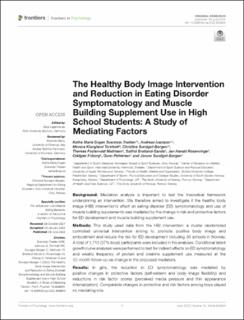| dc.contributor.author | Svantorp-Tveiten, Kethe Marie Engen | |
| dc.contributor.author | Ivarsson, Andreas | |
| dc.contributor.author | Torstveit, Monica Klungland | |
| dc.contributor.author | Sundgot-Borgen, Christine | |
| dc.contributor.author | Mathisen, Therese Fostervold | |
| dc.contributor.author | Bratland-Sanda, Solfrid | |
| dc.contributor.author | Rosenvinge, Jan Harald | |
| dc.contributor.author | Friborg, Oddgeir | |
| dc.contributor.author | Pettersen, Gunn | |
| dc.contributor.author | Sundgot-Borgen, Jorunn | |
| dc.date.accessioned | 2023-02-01T09:17:21Z | |
| dc.date.available | 2023-02-01T09:17:21Z | |
| dc.date.created | 2022-01-27T07:45:17Z | |
| dc.date.issued | 2022 | |
| dc.identifier.citation | Frontiers in Psychology. 2022, 13, Artikkel 803654. | en_US |
| dc.identifier.issn | 1664-1078 | |
| dc.identifier.uri | https://hdl.handle.net/11250/3047651 | |
| dc.description.abstract | Background: Mediation analysis is important to test the theoretical framework underpinning an intervention. We therefore aimed to investigate if the healthy body image (HBI) intervention’s effect on eating disorder (ED) symptomatology and use of muscle building supplements was mediated by the change in risk and protective factors for ED development and muscle building supplement use. Methods: This study used data from the HBI intervention: a cluster randomized controlled universal intervention aiming to promote positive body image and embodiment and reduce the risk for ED development including 30 schools in Norway. A total of 1,713 (37% boys) participants were included in the analyses. Conditional latent growth curve analyses were performed to test for indirect effects on ED symptomatology and weekly frequency of protein and creatine supplement use measured at the 12-month follow-up via change in the proposed mediators. Results: In girls, the reduction in ED symptomatology was mediated by positive changes in protective factors (self-esteem and body image flexibility) and reductions in risk factor scores (perceived media pressure and thin appearance internalization). Comparable changes in protective and risk factors among boys played no mediating role. Conclusion: Interventions aiming to reduce the risk of ED development in girls may benefit from aiming to enhance self-esteem and body image flexibility and reduce perceived media pressure and thin appearance internalization. Future studies should investigate the casual relationship between muscle building supplement use and risk and protective factors for ED development in both girls and boys. | en_US |
| dc.language.iso | eng | en_US |
| dc.publisher | Frontiers Media S.A. | en_US |
| dc.subject | body image | en_US |
| dc.subject | eating disorder | en_US |
| dc.subject | ED | en_US |
| dc.subject | mental health | en_US |
| dc.subject | adolescence | en_US |
| dc.subject | prevention | en_US |
| dc.subject | muscle building supplements | en_US |
| dc.title | The Healthy Body Image intervention and reduction in eating disorder symptomatology and muscle building supplement use in high school students: a study of mediating factors | en_US |
| dc.type | Peer reviewed | en_US |
| dc.type | Journal article | en_US |
| dc.description.version | publishedVersion | en_US |
| dc.subject.nsi | VDP::Samfunnsvitenskap: 200::Psykologi: 260::Andre psykologiske fag: 279 | en_US |
| dc.source.volume | 13 | en_US |
| dc.source.journal | Frontiers in Psychology | en_US |
| dc.identifier.doi | 10.3389/fpsyg.2022.803654 | |
| dc.identifier.cristin | 1990901 | |
| dc.source.articlenumber | 803654 | en_US |
| cristin.ispublished | true | |
| cristin.fulltext | original | |
| cristin.qualitycode | 1 | |
